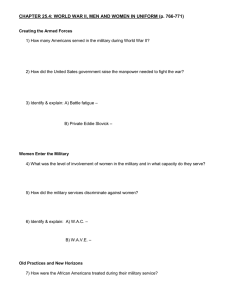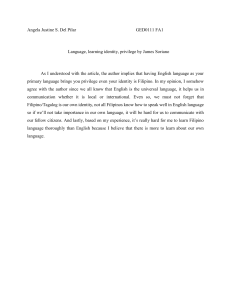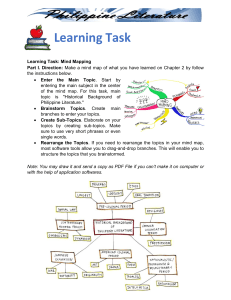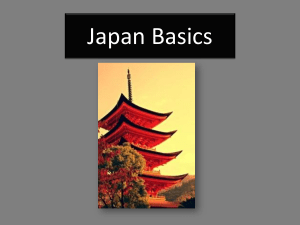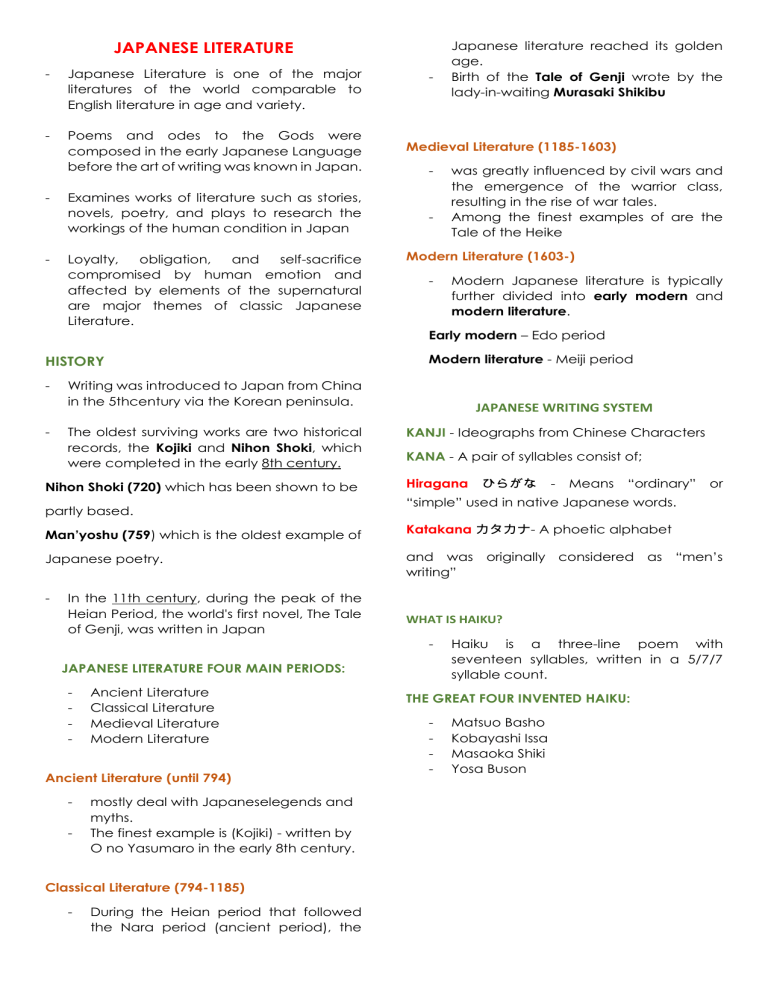
JAPANESE LITERATURE - Japanese Literature is one of the major literatures of the world comparable to English literature in age and variety. - Poems and odes to the Gods were composed in the early Japanese Language before the art of writing was known in Japan. - - Examines works of literature such as stories, novels, poetry, and plays to research the workings of the human condition in Japan Loyalty, obligation, and self-sacrifice compromised by human emotion and affected by elements of the supernatural are major themes of classic Japanese Literature. HISTORY - - Medieval Literature (1185-1603) - - The oldest surviving works are two historical records, the Kojiki and Nihon Shoki, which were completed in the early 8th century. partly based. Man’yoshu (759) which is the oldest example of Japanese poetry. In the 11th century, during the peak of the Heian Period, the world's first novel, The Tale of Genji, was written in Japan - Modern literature - Meiji period JAPANESE WRITING SYSTEM KANJI - Ideographs from Chinese Characters KANA - A pair of syllables consist of; Hiragana ひらがな - Means “ordinary” or “simple” used in native Japanese words. Katakana カタカナ- A phoetic alphabet and was originally considered as “men’s writing” WHAT IS HAIKU? JAPANESE LITERATURE FOUR MAIN PERIODS: Ancient Literature Classical Literature Medieval Literature Modern Literature Ancient Literature (until 794) - mostly deal with Japaneselegends and myths. The finest example is (Kojiki) - written by O no Yasumaro in the early 8th century. Classical Literature (794-1185) - During the Heian period that followed the Nara period (ancient period), the Modern Japanese literature is typically further divided into early modern and modern literature. Early modern – Edo period - - was greatly influenced by civil wars and the emergence of the warrior class, resulting in the rise of war tales. Among the finest examples of are the Tale of the Heike Modern Literature (1603-) Writing was introduced to Japan from China in the 5thcentury via the Korean peninsula. Nihon Shoki (720) which has been shown to be - - Japanese literature reached its golden age. Birth of the Tale of Genji wrote by the lady-in-waiting Murasaki Shikibu Haiku is a three-line poem with seventeen syllables, written in a 5/7/7 syllable count. THE GREAT FOUR INVENTED HAIKU: - Matsuo Basho Kobayashi Issa Masaoka Shiki Yosa Buson PHILIPPINE LITERATURE ANCIENT LITERATURE/ FOLK LITERATURE Pre-colonial period (BC to 1564) This period is mostly based on oral traditions and crude on ideology and phraseology. ORAL LITERATURE - Riddles (bugtong), Tanaga Proverbs (salawikain), WELL-KNOWN LITERATURE NOLI ME TANGERE “Touch me not” - 1887 - It explores perceived inequities in law and practice in terms of the treatment by the ruling government. languages used: Spanish and Latin EL FILIBUSTERISMO FOLK SONGS “The Reign of Greed” - Folk lyric used to express hopes and aspirations FOLK TALES - 1889 - It was the second novel which is the sequel to Noli Me Tangere. It is the story of the last days - Myths, Legends, Fables, Fantastic stories languages used: Spanish EPICS Author: Jose Protacio Rizal Mercado Y. Alonso Realonda - Lengthy narratives based on oral tradition revolving around supernatural events or heroic deeds. LITERATURE UNDER SPANISH PERIOD SPANISH COLONIZATION PERIOD (1565 TO 1863) This period is classified into two distinctions; religious and secular. It also introduced Spanish as the medium of communication. Birth: June 19, 1861 Died: age of 35 IBONG ADARNA - a 16th century filipino epic poem. It is about an eponymous magical bird. 3 BROTHERS: Don Juan, Don Pedro, Don Diego Language: Tagalog RELIGIOUS LITERATURE Author: Jose de la Cruz - Religious lyrics written by ladino poets. Used to teach Filipinos the Spanish language. - Known as Huseng Sisiw - 1746-1829 - He was one of the great Tagalog writers during the spanish colonization of the Philippines. - He was said to be the mentor of Francisco Balagtas. SECULAR (NON-RELIGIOUS) LITERATURE - Awit, Korido, Prose narratives CONTEMPORY LITERATURE FORMS THE REBIRTH OF FREEDOM (1946 TO PRESENT) The early post-liberation period was marked by liberation and nationalism. As time goes by, Filipino writers continued to write about social issues, gender/ethnic related topics and for personal intentions. FILIPINO POETRY Poems during the Third Republic were romantic and revolutionary. Writers also included colorful, violent and insulting languages in their works. FILIPINO SONGS Many Filipino songs dealt with themes that were really true-to-life such as grief, poverty, freedom, love of God, of country and of fellowmen. FLORANTE AND LAURA - 1838-1815 - Is a philippine literary classical, deemed an intergal part of Filipino experience. - 1,722 stanza Language: Tagalog Author: Francisco Balagtas Baltazar - 1788-1862 - He was a Filipino poet and literature of the Tagalog language during Spanish rule in the Philippines - Student of Huseng sisiw AMERICAN LITERATURE COLONIAL PERIOD was an American writer, editor, and literary critic known for his poetry and short stories, particularly his tales of mystery and suspense the inventor of detective fiction Influenced by European settlers Notable work: THE RAVEN PERIODS OF AMERICAN LITERATURE THE ROMANTIC PERIOD 1830-1870 emphasized nature, symbolism, transcendentalism, and individualism. Key authors of this period: Emily Dickinson Edgar Allan Poe REALISM AND NATURALISM 1870-1910 Focused on ordinary characters ordinary, everyday life situations - Publication date: 1845 Lenore- namatay na di makalimutan ng boy EMILY DICKINSON one of the most powerful voices of American culture poems deal with themes of death and immortality explore aesthetics, society, nature, and spirituality Notable work: “Hope” is the thing with feathers - THE MODERNIST PERIOD 1910-1945 These three techniques; - Fragmentation; - stream of consciousness; - free verse. Modernism THE CONTEMPORARY PERIOD 1945-Present Reflects the current political, social, and broader personal issues of the time Very realistic characters Writing styles that are easy to read The desire to experiment with new genres GREATEST AMERICAN AUTHORS NATHANIEL HAWTHORNE Novelist and short story writer Works have been labelled ‘dark romanticism the never-ending remembrance hope doesn't speak to us in a conventional way: it is a feeling that we get, not always a rational one, that helps us to overcome difficulties. Publication date: 1861 ERNEST HEMINGWAY was a novelist, short story writer, and journalist He published seven novels, six short story collections, and two non-fiction works won the Nobel Prize for Literature in 1954 Notable work: THE OLD MAN AND THE SEA - portray every man and woman's battle for meaning and success in their life. Publication date: 1952 Characters: Santiago – the marlin Pedrico- binigyan ng isda ni Santiago Manolin – kasama ni Santiago Notable work: THE SCARLET LETTER - a scarlet A worn as a punitive mark of adultery. Publication date: 1950 Genre: Romantic, Historical Characters: Hester Prinne – nangabit Roger Chillingworth – real husband Reverend Arthur Dimmesdale – lover ni hester TONI MORRISON known for their vivid dialogue, their detailed characters and epic themes awarded both the Pulitzer Prize and the American Book Award in (1988) for Beloved, and the Nobel Prize for Literature in (1993) Notable work: BELOVED - he works examines the destructive legacy of slavery as it chronicles the life of a Black Pearl – anak ni Hester at Arthur Publication date: 1987 EDGAR ALLAN POE Characters: Sethe – mother Denver – anak na babae Beloved – toddler na namatay at sumapi JOHN STEINBACK author of 16 novels and various other works, including five short story collections. He is widely known for the novels, East of Eden Notable work: EAST OF EDEN - follows the intertwined destinies of two families— the Trasks and the Hamilton’s—whose generations helplessly reenact the fall of Adam and Eve and the poisonous rivalry of Cain and Abel. Publication date: 1952 Characters: Cain- bad Abel- good JOSEPH HELLER was an American writer of satirical novels, short stories and plays the great American anti-war satire, Catch 22 Notable work: CATCH 22 Publication date: 1961 ARTHUR MILLER was a play wright and ‘great man’ of American theatre, which he championed throughout his long life. His many dramas were among the most popular by American authors and several are considered to be among the best American plays Notable work: THE DEATH OF A SALESMAN Publication date: 1949 Characters: Willy Loman- father Biff ad Happy – son of Willy AFRICAN LITERATURE - ORATURE/ORAL LITERATURE Ugandan- Piu Sorimu Pre-Colonial Literature Epic of Sandiata – composed medieval mali Epic of Dinga – Old Ghana Empire Kebra nagast/The book of Kings - 117 chapters Best work in this traditional Trickster story – Traditional African Folktale Colonial Literature Joseph Ephraim Casely Hayford - Published the first African novel written in English Work: Ethiopia Unbound - 1st African novel written in English. Herbert Isaac Ernest Phlomo - Published 1st English language African play Work: The Girl Who Like to be Saved - 1st language African Play Ngugi wa Thiong’O - Wrote 1st east African drama Work: Black Hermit - First east African drama Chinua Achebe - Nigerian novelist, professor and critic Won the man booker international prize in 2007 Father of modern African writing 30 honorary degrees Works: - Things fall apart No longer at ease Arrow of god Man of the people HEBREW LITERATURE FAST FACTS ON THE STATE OF ISRAEL CAPITAL: JERUSALEM FINANCIAL CENTER: TEL AVIV CURRENCY: ISRAELI NEW SHEKEL ANTHEM: HATIKVAH THE HOPE DEMONYM: ISRAELI RELIGION: MONOTHEISTIC JEHOVA DATE OF STABLISHMENT: MAY 14, 1948 TYPE OF GOVERNMENT: UNITARY PARLIAMENTARY GOVERNMENT HEAD OF GOVERNMENT: PRIME MINESTER LEGISLATIVE BODY: KNESSET TOTAL LAND AREA: 8,019/8,522 SQ MILES HISTORY OF THE NAME ISRAEL-New name of Jacob after he wrestled with an angel MEMEPTAH STELE- First record of the name Israel. It said “Israel is laid waste, his seed is no more.” THE FLAG BLUE STRIPES- The Tallit (Prayer Shawl) Star of David (Magen David or Shield of David)- the Jewish people and Judaism. White- Chesed (Devine benevolence) Blue- Gevurah (God’s severity) God’s glory and purity TOURIST SPOTS - THE WAILING WALL OR WESTERN WALL (JERUSALEM) CHURCH OF THE NATIVITY (BETHLEHEM) OPEN DOORS (RISHON LEZION MEMORIAL PARK) THE LANGUAGE AND ALEFBET - 23 Consonants 4 have socondary vowels Written from right to left Alef (first letter) Tav (Last letter) Each letter has numerical values
